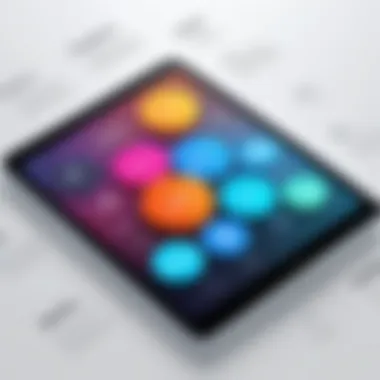Cost Analysis of the iPad 10.2: Insights and Implications


Intro
The iPad 10.2 stands out in the diverse tablet market, appealing particularly to IT professionals and tech enthusiasts. As we examine the cost implications, it is essential to understand not only its retail pricing but also its market placement and technical specifications. Analyzing how these elements interplay can yield significant insights into its value.
Product Overview
The iPad 10.2 is designed to serve a broad spectrum of users, from casual consumers to professionals seeking reliability and performance. This section evaluates its key features and technical specifications, setting the foundation for a comprehensive cost analysis.
Key Features
- Display: Featuring a 10.2-inch Retina display, it offers vibrant colors and sharp graphics, enhancing media consumption and productivity.
- Processor: Powered by the A13 Bionic chip, it provides impressive performance for both everyday tasks and demanding applications.
- Apple Pencil Compatibility: This device supports the first-generation Apple Pencil, catering to creative professionals and students alike.
- iPadOS: The operating system designed specifically for iPads adds multitasking capabilities and smooth integration with other Apple services.
Technical Specifications
Here are some notable technical specs of the iPad 10.2:
- Size: 10.2 inches
- Weight: Approximately 1.07 pounds
- Processor: A13 Bionic chip
- Storage Options: Available in 32GB and 128GB configurations
- Camera: 8MP rear and 12MP ultra-wide front camera
- Battery Life: Up to 10 hours of surfing the web on Wi-Fi or watching video
Performance Analysis
Understanding the iPad 10.2's performance is crucial for potential buyers to evaluate its practical value compared to its cost.
Benchmark Test Results
Recent benchmark testing highlights the device's capabilities:
- In Geekbench 5, it scores approximately 1,300 in single-core performance and around 3,300 in multi-core tasks, placing it competitively among mid-range tablets.
- Graphics performance, measured by 3DMark, shows robust capabilities suitable for casual gaming and light graphic design work.
Real-World Usage Scenarios
In actual use, the iPad 10.2 excels in various scenarios:
- Office Tasks: Seamless operation when using applications like Microsoft Office or Google Workspace facilitates productivity for professionals.
- Content Consumption: Streaming services, reading, and browsing work smoothly, thanks to the vibrant display and solid battery life.
- Creative Work: With Apple Pencil support, users can engage in drawing or note-taking effectively, making it a versatile tool for students and artists.
"The iPad 10.2 combines performance and affordability, positioning itself as an attractive option for many users."
Culmination
As the iPad 10.2 continues to evolve, it is crucial to reflect on the cost implications of investing in this device. By examining its features, technical specifications, and performance in real-life applications, users can better assess its overall value in the competitive tech landscape. The strategic considerations discussed offer a roadmap for IT professionals and tech enthusiasts, guiding them toward an informed decision.
Foreword to the iPad 10.
The launch of the iPad 10.2 represents a significant development in the tablet market. Its positioning suggests a careful blend of functionality and affordability. This section will provide an essential overview of the product and explore the demographics that the iPad 10.2 appeals to.
Overview of Product Launch
Apple introduced the iPad 10.2 in September 2020 as part of its ongoing strategy to dominate the tablet sector. This model fits between the budget and premium segments, aiming at both casual consumers and educational institutions. The launch emphasized its enhanced specifications such as the A12 Bionic chip, larger display, and compatibility with first-generation Apple Pencil and Smart Keyboard. Such upgrades increase its appeal, promising a balance between performance and cost.
The significant focus was placed on providing educational tools and enhancing remote learning experiences, making it relevant during the time of increasing distance education due to global events. As such, the iPad 10.2 not only serves as a consumer device but also as a practical tool for students and educators.
Target Audience and Market Segment
The iPad 10.2 distinctly targets a broad audience. Its market segmentation includes:


- Students: The educational features, including support for the Apple Pencil, attract a younger demographic.
- Professionals: Many IT professionals may find its functionality useful for mobile productivity without compromising on power.
- Casual Users: Individuals looking for a reliable and simple device for media consumption, browsing, and light productivity.
By understanding these segments, Apple aims to meet diverse user needs with a single device. The price point strategically positions the iPad 10.2 as more accessible than the Pro models while still delivering notable performance.
The iPad 10.2 serves as a bridge between affordability and performance, appealing to a variety of user groups.
This analysis of the iPad 10.2 helps highlight its importance in the current market landscape, emphasizing why understanding its cost implications is vital for potential buyers.
Retail Pricing of the iPad 10.
Understanding the retail pricing of the iPad 10.2 is crucial for potential buyers and tech enthusiasts. Pricing reflects not only the manufacturing costs but also market strategy and consumer expectations. Accurate knowledge of the price framework can guide informed purchasing decisions. Factors such as competition, technological advancements, and brand positioning play significant roles. Moreover, pricing affects perceived value, influencing user satisfaction and product longevity.
Base Model Pricing
The base model of the iPad 10.2 has a starting price, which sets the standard for its market category. This price point is designed to attract a broad audience, positioning the iPad as a versatile tool for both casual users and professionals. As per the latest data, the base model is competitively priced compared to similar devices, offering substantial features for its cost. The optimization of this pricing strategy allows Apple to cater to a diverse demographic, from students to educators and working professionals.
Add-On Features and Costs
While the base model offers significant value, additional features can enhance the user experience. Optional add-ons, such as extra storage or accessories like the Apple Pencil and Smart Keyboard, carry extra charges. These features allow users to customize their iPad to fit specific needs, though they can increase the overall cost considerably. Understanding these supplemental costs helps consumers assess the total financial commitment associated with the purchase of the iPad 10.2, making them more equipped to make decisions based on their requirements and budgets.
Regional Pricing Variations
Retail pricing for the iPad 10.2 can vary significantly across different regions. This variance is often influenced by factors such as local taxes, import duties, and competitive market dynamics. Consumers in different locations should be acutely aware of these differences, as they can affect the final purchase price. Moreover, Apple may adjust prices to reflect currency fluctuations or regional economic conditions, creating distinct pricing landscapes globally.
"Understanding price variances is important for savvy consumers who want to maximize their investment."
Ultimately, analyzing the regional pricing is essential for buyers who are looking to buy the iPad 10.2 outside their home country. Knowledge of these nuances can influence purchasing strategies and help consumers avoid unnecessary expenses.
Comparative Pricing Analysis
The Comparative Pricing Analysis effectively illuminates how the iPad 10.2 stacks up against its competitors while evaluating historical price patterns. This section seeks to provide a contextual backdrop that will inform potential buyers about what they can expect, making it an essential part of this comprehensive cost analysis. Comparative pricing allows consumers to justify their investment by examining features, performance, and overall value relative to similar devices in the market.
Versus Competitor Devices
When analyzing the iPad 10.2 against competitors like the Samsung Galaxy Tab S6 Lite and Microsoft Surface Go 2, several factors emerge. First, the iPad typically offers a cohesive software ecosystem, which many users find appealing. The seamless integration of iPadOS with various Apple applications, like Pages and Keynote, makes it a strong contender.
On the pricing front, while the iPad 10.2 entry-level model starts at around $329, the Samsung Galaxy Tab S6 Lite presents a more affordable option at approximately $349. However, it is important to note that the overall performance differs. For instance:
- Display Quality: The iPad provides a Retina display, well-suited for most tasks, while the Galaxy Tab S6 Lite has a slightly lower-resolution screen.
- Processor Performance: Apple's A12 Bionic chip notably outperforms the Snapdragon processor found in Samsung's offering. This results in faster application loading times and more competent multitasking capabilities.
It is vital to consider that these price points vary depending on add-ons and regional specifications. Certain specifications can cause the total cost to fluctuate significantly. Moreover, customer support and warranty options also play a role in the comparative pricing evaluation. Users generally report more positive support experiences with Apple compared to some competitors.
Historical Price Trends for iPad Models
Understanding historical price trends is crucial when analyzing the current pricing of the iPad 10.2. Apple tends to maintain stable prices for its products over extended periods. The entry-level models, like the iPad 10.2, have historically remained around the $329 mark since their launch.
By examining previous models:
- iPad 9: Launched at the same price point, maintained a similar value trajectory.
- iPad 8 and earlier models: These devices typically saw a price drop after their successors launched, although they often still retained good resale value, particularly among tech enthusiasts.
This pattern indicates a relationship between product launches and pricing, where older models may decrease in cost but still hold value in the secondary market. The iPad 10.2 benefits from this historical context, possibly solidifying its position as a wise investment for those considering longevity in ownership.
In summary, the comparative pricing analysis of the iPad 10.2 equips consumers with critical insights that enhance their purchasing decisions. By juxtaposing it against competitor devices and examining historical trends, prospective buyers can better assess value and performance in a competitive marketplace.
Cost of Ownership


Understanding the cost of ownership is essential for anyone considering the iPad 10.2. This concept encompasses various financial aspects following the initial purchase. Evaluating the total cost affords potential buyers a broader perspective on their long-term investment. The costs to consider include the initial purchase price, future resale value, and ongoing maintenance or operating expenses. By analyzing these elements, consumers can make informed decisions that align with their financial goals and technology needs.
Initial Purchase Cost
The initial purchase cost is the most straightforward aspect of ownership. For the iPad 10.2, the base model pricing sets the stage for understanding its market value. The starting price for the entry-level version is approximately $329. This amount reflects a competitive positioning within the tablet market, balancing quality and functionality.
However, buyers should be aware that the expense does not just end with the base model. Options for increased storage or cellular capabilities elevate the total. For instance, the higher-grade models with additional storage can range up to $479. This tiered pricing structure allows consumers to choose their device according to their requirements but emphasizes the necessity of assessing one’s budget precisely. Understanding these costs upfront helps buyers avoid unexpected financial dilemmas later on.
Long-Term Value and Resale Potential
When considering an investment in any technology, evaluating its long-term value is crucial. The iPad 10.2 has a reputation for durability and extended software support. This means that the device remains functional and relevant longer than many competitors, potentially extending its usable life significantly beyond typical expectations.
Moreover, resale potential is a key component of long-term value. Devices like the iPad tend to hold value relatively well compared to other tablets, especially when well-maintained—this can lead to the possibility of recouping some costs through resale. Users might expect to get approximately 50% of the original price if they sell after a couple years, depending on the condition and market demand. This factor further enhances the attractiveness of the iPad 10.2 as a worthwhile investment.
Maintenance and Operating Expenses
While the initial and resale costs capture significant attention, maintenance and operating expenses also play a crucial role in the overall cost of ownership. These may include accessories such as cases or screen protectors and potential software purchases or subscriptions for applications like Microsoft Office or Adobe Creative Suite.
On average, users might spend around $50 to $150 annually on app subscriptions and accessories. Furthermore, considering the average lifespan of an iPad, these ongoing costs need to be factored into the ownership equation. Although maintenance for an iPad is often lower than for other devices, awareness of these expenses serves users better in preparing their budgets.
"Understanding the total cost of ownership is vital for making an informed decision about investing in the iPad 10.2."
In summary, the cost of ownership articulates a comprehensive financial picture. Initial purchase, potential resale, and recurring costs blend together to shape an insightful view of what users can expect when integrating the iPad 10.2 into their lives.
Value Proposition for IT Professionals
In examining the cost ramifications of the iPad 10.2, it is crucial to understand its value proposition for IT professionals. This segment of users often demands a device that meets specific functional needs while maintaining an efficient workflow. The iPad 10.2 offers features that cater to these requirements, balancing price with performance. It holds relevance not just as a personal device but as a tool that can enhance productivity in professional settings.
Functional Efficiency and Productivity
The iPad 10.2 boasts a range of features that directly contribute to improved efficiency in daily tasks. With its A12 Bionic chip, the performance of applications is swift, allowing professionals to handle data-heavy tasks seamlessly. Multitasking capabilities are also enhanced with support for Split View and Slide Over, making it easier to work on multiple projects simultaneously. The device's portability means it can be utilized in various environments, whether in the office or on the go, ultimately supporting a flexible workflow.
Key benefits include:
- Fast processing speeds for applications.
- Improved multitasking with intuitive interface.
- Portability that suits remote work needs.
Software Ecosystem and Application Compatibility
IT professionals often rely on an ecosystem that offers reliable software solutions. The iPad 10.2 operates on iPadOS, granting access to a vast array of applications suitable for professional use. Compatibility with essential software like Microsoft Office, Adobe suite, and various project management tools makes it a versatile choice for IT experts. Its ability to run powerful applications alongside user-friendly apps without system lag is a significant advantage, especially for those who require robust software solutions.
The vast App Store further enriches the device's value, providing thousands of tools designed to enhance productivity, collaboration, and communication. This level of compatibility can significantly reduce the time spent training employees on new software, as many are likely already familiar with the iPad interface.
Integration with Other Apple Devices
Another compelling element of the iPad 10.2's value proposition is its seamless integration with other Apple devices. Many IT professionals often use multiple devices such as iPhones and MacBooks. The ability to share files through AirDrop, continue tasks from one device to another with Handoff, and synchronize data via iCloud simplifies the workflow. This integration results in time savings and a cohesive user experience.
"Seamless integration with Apple’s ecosystem significantly enhances task management and improves overall productivity."
This interoperability makes the iPad 10.2 not just a gadget but a central hub for various work tasks, aligning perfectly with the needs of tech professionals. As organizations increasingly adopt hybrid work models, the importance of such integration cannot be overstated. Products like the iPad 10.2 serve as a bridge between mobility and functionality, underscoring their value in the contemporary workplace.
Consumer Feedback and Market Reception
In the discussion surrounding the iPad 10.2, understanding consumer feedback and market reception is crucial. This section delves deeper into how users perceive the device and the implications of their opinions on market trends and purchase decisions. Consumer feedback shapes product development, influences future models, and signifies the device's overall acceptance in a competitive tech industry.
User Reviews and Ratings


User reviews for the iPad 10.2 reveal a complex interplay of satisfaction and frustration among different groups of users. Many individuals highlight the ease of use, portability, and performance of the device. Reviews often note that the iPad 10.2 is suitable for a variety of tasks, ranging from basic browsing to more demanding educational applications.
However, critiques also emerge, particularly regarding limitations in hardware compared to other models. For instance, several users express disappointment with the camera quality and lack of advanced features found in higher-priced options. These sentiments can significantly impact potential buyers' choices. Users value consistent and honest feedback, as this shapes their expectations.
In digital platforms like Reddit and Facebook, discussions offer an open forum for consumers to express opinions and post experiences. The online community allows for direct engagement with both satisfied and dissatisfied users, creating a lively discourse that can enhance or diminish the device's reputation. Aggregated ratings from various sources indicate a generally positive reception, though fluctuations exist depending on specific user needs.
Expert Analysis and Tech Reviews
Expert reviews play an important role in contextualizing user experiences. Tech enthusiasts look to professionals for insights that go beyond personal experiences. For example, reviews from benchmark testing indicate that the iPad 10.2 performs admirably in daily scenarios, yet there are critiques regarding its longevity and competition in its price range.
Many tech reviewers assess the iPad 10.2 concerning alternatives like the Microsoft Surface Go or the Samsung Galaxy Tab series. Analysts often note that the iPad 10.2 delivers commendable performance but lacks some premium features such as higher resolution displays found in pricier options.
Moreover, the software ecosystem surrounding the iPad 10.2 is under constant scrutiny. Many experts emphasize the optimization of Apple's iOS for the device, allowing it to maintain relevance in an era of rapid technological advancement. This draws in a crowd of users looking to integrate their iPad with other Apple devices.
"The constant updates to iOS ensure that the iPad 10.2 remains capable and relevant as new applications emerge."
Closure
The conclusion serves as a pivotal aspect of this article, summarizing the intricate cost analysis and its implications concerning the iPad 10.2. As we have thoroughly explored the various dimensions of costs associated with this device, it is essential to draw together key insights that affect both consumers and IT professionals.
Summary of Cost Implications
The financial commitment to purchase an iPad 10.2 extends beyond the initial retail price. Factors such as operational costs, potential resale value, and available add-ons all contribute to the total cost of ownership. Understanding these implications is crucial for making an informed decision.
- Initial Costs: The base model pricing is competitive compared to other tablets in the market, but the investment can grow quickly when considering accessories and higher storage options.
- Ongoing Expenses: Monthly fees related to apps, subscriptions, and potential repairs must also be anticipated.
- Resale Value: The iPad models typically retain a significant portion of their original value, making resale a viable option for users who frequently upgrade.
Statistics suggest that Apple devices hold their value better than most competitors, which is an important factor for potential buyers to weigh in their decision-making process.
"Investing in an iPad 10.2 not only affects upfront expenditures but has long-term implications as well."
Final Thoughts on Purchase Considerations
When considering the iPad 10.2, it is imperative to evaluate the features that align with specific needs. For IT professionals and tech enthusiasts, key considerations include:
- Functionality: Assess the performance capability needed for tasks, from light browsing to demanding applications.
- Ecosystem: Integration with other Apple products can enhance productivity, especially for those already utilizing iPhones or MacBooks.
- Longevity: Investing in a device that provides not just immediate satisfaction but future-proofing is essential in today's fast-paced tech environment.
Ultimately, the decision to purchase the iPad 10.2 should encompass a holistic view of costs, features, and how it fits into the broader tech ecosystem. An astute analysis will yield not just a device but a strategic tool for both personal and professional growth.
Appendix and Additional Resources
In any thorough analysis, especially one focused on costs and implications, the appendices and additional resources form a cornerstone for further exploration. They offer readers the insights needed to delve deeper into complex topics, ensuring that all angles are covered. This is particularly vital for an analysis like that of the iPad 10.2, where various elements must connect logically for full comprehension.
References and Further Reading
References serve as the backbone of credibility in an article. For readers seeking to expand their understanding of the iPad 10.2 and its market context, a selection of carefully chosen references enhances the depth of the analysis.
Some recommended readings include:
- The official Apple website for detailed specs and updates.
- Academic journals on technology assessments, providing critiques and insights based on empirical data.
- Various tech blogs where experts discuss new tech trends.
- The Wikipedia page on tablet computing, which offers evolution context and comparisons to other devices.
These resources not only anchor arguments presented but also guide readers toward reputable information. Understanding how the iPad fits into the broader landscape requires acknowledging both scholarly and practical perspectives.
Comparison Charts and Tables
Visual aids like charts and tables can simplify complex information, making it more accessible. Compared to dense paragraphs, these tools quickly convey critical cost data or specifications, aiding readers in grasping trends and relationships.
Including comparison tables between the iPad 10.2 and competing devices allows for a straightforward analysis of specifications, pricing, and features. Key elements to consider in charts are:
- Base model pricing compared to competitors like Samsung Galaxy Tab A and Microsoft Surface Go.
- Performance benchmarks in productivity apps.
- Long-term cost of ownership calculations, such as maintenance and warranty options.
Ultimately, these resources enhance the reading experience. They turn intricate detail into digestible information that aligns with the analytical nature of the article, serving both tech enthusiasts and IT professionals effectively.



